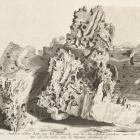In the fall of 1730 following a relatively minor storm, Dutch dike inspectors in the province of Zeeland discovered a little-known “worm” embedded in the wave breakers that buffered coastal dikes. The animal bored into their wooden components, creating a honeycomb of passages that caused them to snap during the storm. The invader was the naval shipworm (Teredo navalis), a cryptogenic marine mollusk, now found worldwide. Subsequent inspections on the island revealed that nearly every dike protected with wood contained shipworms, prompting a crisis of existential proportions. Without these barriers, the earthen bodies of sea dikes would be directly subjected to the erosive force of storm surges. The shipworm infestation “cannot be seen as anything” other than an event of “the utmost consequence, if not total ruin of the island,” acccording to dike inspector Edualdus Reynvaan. News of this novel disaster spread quickly, and by 1731, Dutch inspectors in Holland and the province of Friesland discovered similar infestations along their dikes, sluices, and harbors.
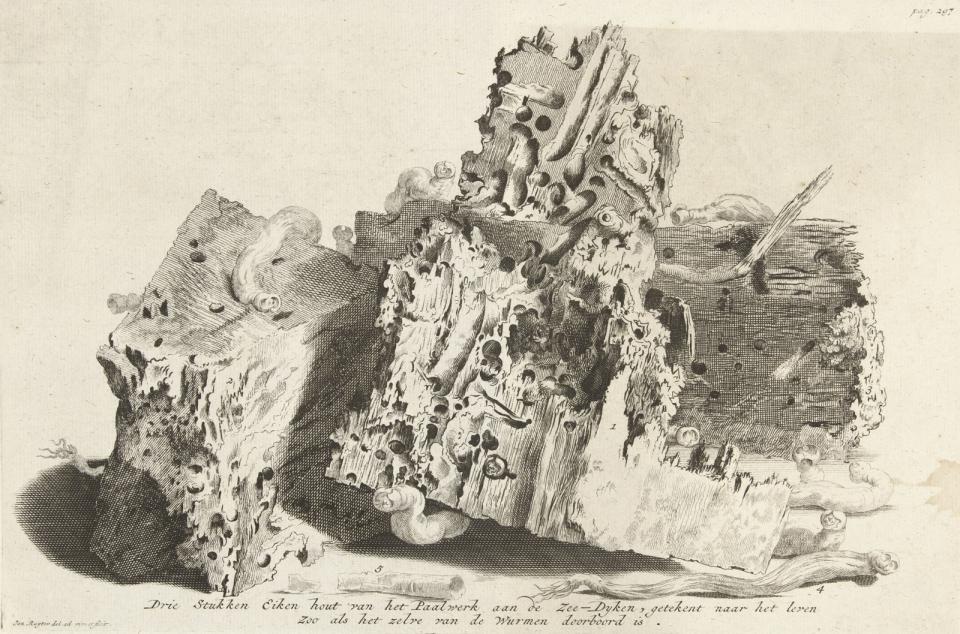
Artistic rendering of the shipworms in “three pieces of oaken wood from the pilework on the sea dikes” drawn “from life”
Artistic rendering of the shipworms in “three pieces of oaken wood from the pilework on the sea dikes” drawn “from life”
Jan Ruyter, Delen paalwerk aangetast door paalwormen, 1731—1733.
Courtesy of Rijksmuseum, Amsterdam.
Click here to view Rijksmuseum source.
 This work is licensed under a Creative Commons Public Domain Mark 1.0 License.
This work is licensed under a Creative Commons Public Domain Mark 1.0 License.
European mariners were already familiar with shipworms like T. navalis before 1730. They had attacked the wooden hulls of trading vessels since antiquity and presented significant challenges for long-term voyages following the expansion of European commerce into the East and West Indies. These new connections likely brought the shipworm to the Netherlands, but their populations did not explode until the fall of 1730 when a series of hot, dry summers likely reduced freshwater river outflow and increased the salinity of the Southern Sea (now called the IJssel Lake) and the Rhine/Meuse Delta region. This combination of temperature and salinity increases created ideal conditions for an outbreak.

Reconstructed salinity of the Rhine/Meuse Delta and conditions of habitats for shipworms with average precipitations.
Reconstructed salinity of the Rhine/Meuse Delta and conditions of habitats for shipworms with average precipitations.
Shipworms survive in salinities greater than about 3‰ (3000 mg Cl‾ /l water and flourish in salinities of 5.5‰ or higher. Below this threshold, salinities become intolerable for the species. This transition is expressed in the map from low salinities (0-3‰) near points of drainage (yellow points) to ideally high salinities (5.5-18.5‰) in progressively brighter green. The red lines indicate dike infestations.
Map created by Adam Sundberg using QGIS.
Sources:
Base Map: Herman Moll, A New and Exact Map of the United Provinces, or Netherlands, &c, 1720.
Click here to view David Rumsey Map Collection.
Digitized isohaline lines from: Wim J. Wolff, The Estuary as a Habitat: An Analysis of Data on the Soft-Bottom Macrofauna of the Estuarine Area of the Rivers Rhine, Meuse, and Scheldt (Leiden: Brill, 1973), 41-42.
 This work is licensed under a Creative Commons Attribution-NonCommercial-NoDerivatives 4.0 International License.
This work is licensed under a Creative Commons Attribution-NonCommercial-NoDerivatives 4.0 International License.
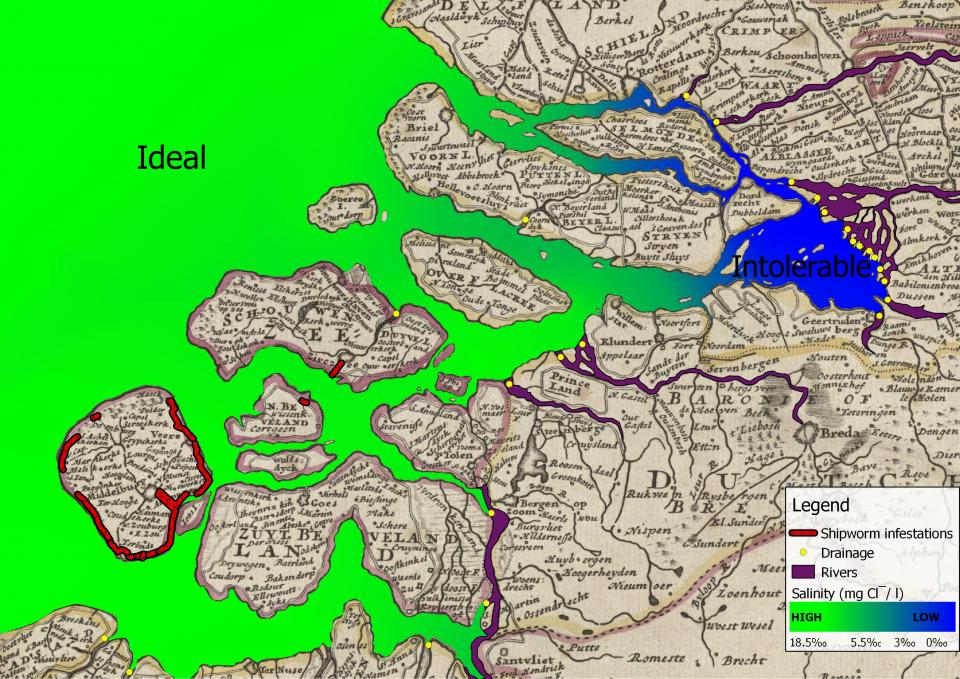
Reconstructed salinity of the Rhine/Meuse Delta and conditions of habitats for shipworms under drought conditions
Reconstructed salinity of the Rhine/Meuse Delta and conditions of habitats for shipworms under drought conditions
This map of the Rhine-Meuse River Delta regions simulates drought conditions by visualizing salinity gradients during low river output. During a drought like the 1730s, less freshwater drainage (yellow points) potentially expanded the ideal habitat of shipworms.
Map created by Adam Sundberg using QGis.
Sources:
Base Map: Herman Moll, A New and Exact Map of the United Provinces, or Netherlands, &c, 1720.
Click here to view David Rumsey Map Collection source.
Digitized isohaline lines from: Wim J. Wolff, The Estuary as a Habitat: An Analysis of Data on the Soft-Bottom Macrofauna of the Estuarine Area of the Rivers Rhine, Meuse, and Scheldt (Leiden: Brill, 1973), 41-42.
 This work is licensed under a Creative Commons Attribution-NonCommercial-NoDerivatives 4.0 International License.
This work is licensed under a Creative Commons Attribution-NonCommercial-NoDerivatives 4.0 International License.
Mariners’ experience with the shipworm largely failed to percolate into public awareness, and over much of the 1730s, Dutch water authorities struggled to adapt to this biological invasion. The shipworm also instigated an international response from natural historians, technocrats, religious authorities, and laypeople who proposed remedies for the “shipworm epidemic.” Proposals ranged from coating piles in tar, to cladding them in copper, to the construction of inland “sleeper dikes” in the event that coastal dikes failed.
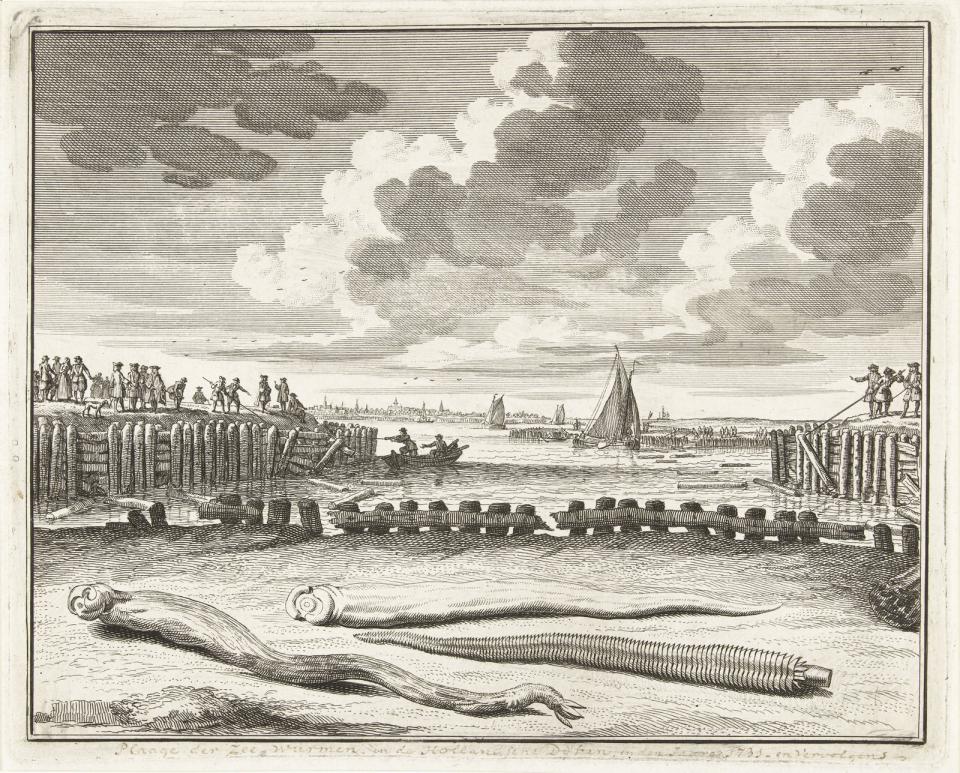
This contemporary print shows dike workers removing piles from a coastal revetment. The exaggerated size of the shipworms was a pictorial convention, but it also accentuated the monstrous interpretation of this invasive species.
This contemporary print shows dike workers removing piles from a coastal revetment. The exaggerated size of the shipworms was a pictorial convention, but it also accentuated the monstrous interpretation of this invasive species.
From Abraham Zeeman, Paalwormen die de dijkbeschoeiïngen aantasten, 1731. Courtesy of Rijksmuseum, Amsterdam.
Click here to view Rijksmuseum source.
 This work is licensed under a Creative Commons Public Domain Mark 1.0 License.
This work is licensed under a Creative Commons Public Domain Mark 1.0 License.
By the end of the 1730s, many regions of the Netherlands had adopted a version of the proposal for redesigned dikes published by two water authorities from Holland named Pieter Straat and Pieter van der Deure. This design broadened and enlarged dike bodies and removed most wooden elements from the water by layering large stones on the seaward slope. By the end of the 1730s, with the return of wet weather and reduced amounts of available wood, the epidemic subsided.
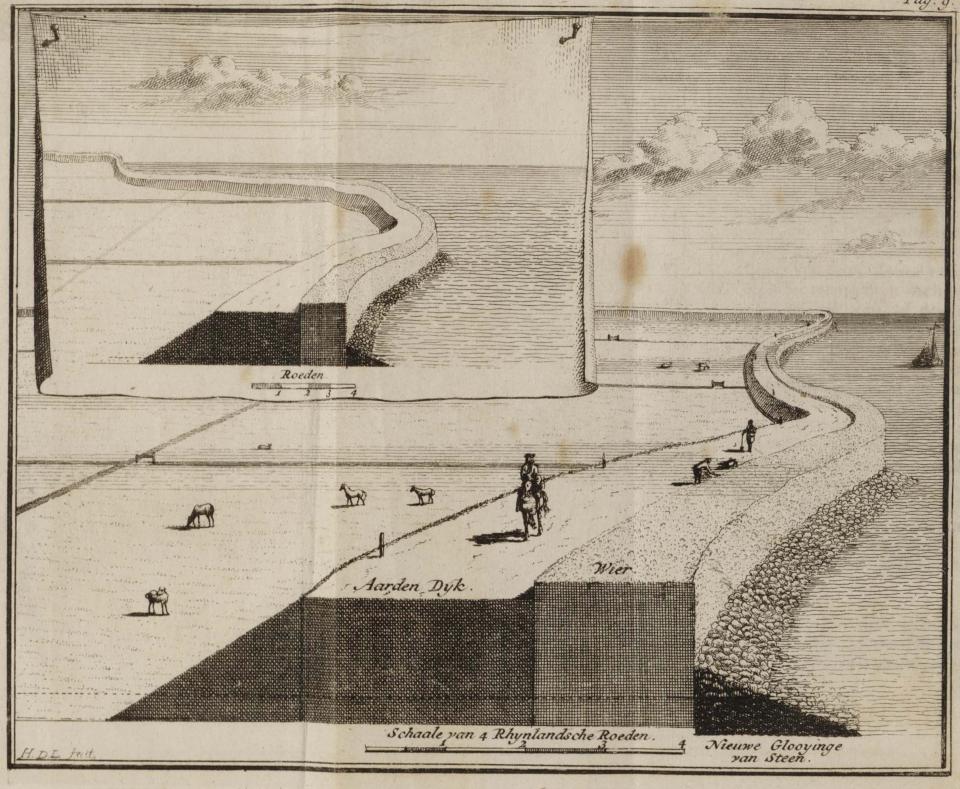
West Frisian water authorities Pieter Straat and Pieter van der Deure published their design for a “new dike slope covered in stone” in a 1735 pamphlet. This image from that pamphlet highlights the West Frisian dike’s broader base, the retention of shock absorbing “wier” (dried sea grass) and the removal of wood from the water, replaced instead with stone on the seaward side.
West Frisian water authorities Pieter Straat and Pieter van der Deure published their design for a “new dike slope covered in stone” in a 1735 pamphlet. This image from that pamphlet highlights the West Frisian dike’s broader base, the retention of shock absorbing “wier” (dried sea grass) and the removal of wood from the water, replaced instead with stone on the seaward side.
From: Straat, P., and P. van der Deure. “Ontwerp Tot Een Minst Kostbaare Zeekerste En Schielykste Herstelling Van De Zorgelyke Toestand Der Westfriesche Zeedyken… Met Een Nader Ontwerp Hoe Men De Dyken Daar De Grootste Dieptens Zyn Op De Zekerste, Minst Kostbaarste En Schielykste Wyze Kan Herstellen… Door Pieter Straat En Pieter Van Der Deure.” Amsterdam: J. Oosterwyk, 1733.
Courtesy of Stichting Rijksmuseum het Zuiderzeemuseum Enkhuizen. Collection Zuiderzeemuseum, inv. nr. BIB 138.
Click here to view Europeana source.
This work is used by permission of the copyright holder.
The shipworm narrative is often treated in Dutch historiography as a technological success story, and without question, Dutch dikes emerged from this disaster stronger than before. The shipworm threat was not eliminated, however. New shipworm infestations emerged sporadically in Holland and across the North Sea in the 1770s and 1850s. These outbreaks once again occurred during droughts, which demonstrated the degree to which environmental and technological conditions mediated outbreaks.
T. Navalis remains an expensive and pervasive threat to wooden structures today. Shipworms continue to threaten wooden harbor infrastructure and ships worldwide and pose a significant challenge for marine archeology. Shipworm infestations will likely increase in significance as climate change and reduced water pollution expand the ecological boundaries of the species.
How to cite
Sundberg, Adam. “Molluscan Explosion: The Dutch Shipworm Epidemic of the 1730s.” Environment & Society Portal, Arcadia (2015), no. 14. Rachel Carson Center for Environment and Society. https://doi.org/10.5282/rcc/7307.
ISSN 2199-3408
Environment & Society Portal, Arcadia
 This work is licensed under a Creative Commons Attribution-NonCommercial-ShareAlike 4.0 International License.
This work is licensed under a Creative Commons Attribution-NonCommercial-ShareAlike 4.0 International License.
2015 Adam Sundberg
This refers only to the text and does not include any image rights.
Please click on an image to view its individual rights status.
- Buisman, Jan. Duizend Jaar Weer, Wind, en Water in de Lage Landen d. 5 (2006), 563–604.
- Hollestelle, Leo. "De Zorg Voor De Zeewering Van Walcheren Ten Tijde Van De Republiek,1574-1795." In Duizend Jaar Walcheren: Over Gelanden, Heren En Geschot, over Binnen- En Buiten Beheer, edited by A. Beenhakker, 103–21. Middelburg: Koninklijk Zeeuwsch Genoots, 1996.
- Paalvast, Peter. Ecological Studies in a Man-Made Estaurine Environment, the Port of Rotterdam. Thesis, Radboud University, Nijmegen (2014).
- Palm, L. C. "De Paalwormepidemie Van 1730." Spiegel Historiael 15 (1980): 266-72.
- Schilstra, Johannes Jouke. In De Ban Van De Dijk: De Westfriese Omringdijk. Hoorn: West-Friesland, 1982.
- Vvan de Ven, G. P. Man-Made Lowlands: History of Water Management and Land Reclamation in the Netherlands. Utrecht: Matrijs, 2004.
- Wolff, Wim J. "Non-Indigenous Marine and Estuarine Species in the Netherlands," Zoologische Mededelingen Leiden 79, no. 1 (2005): 1–116, figs 1–31.



